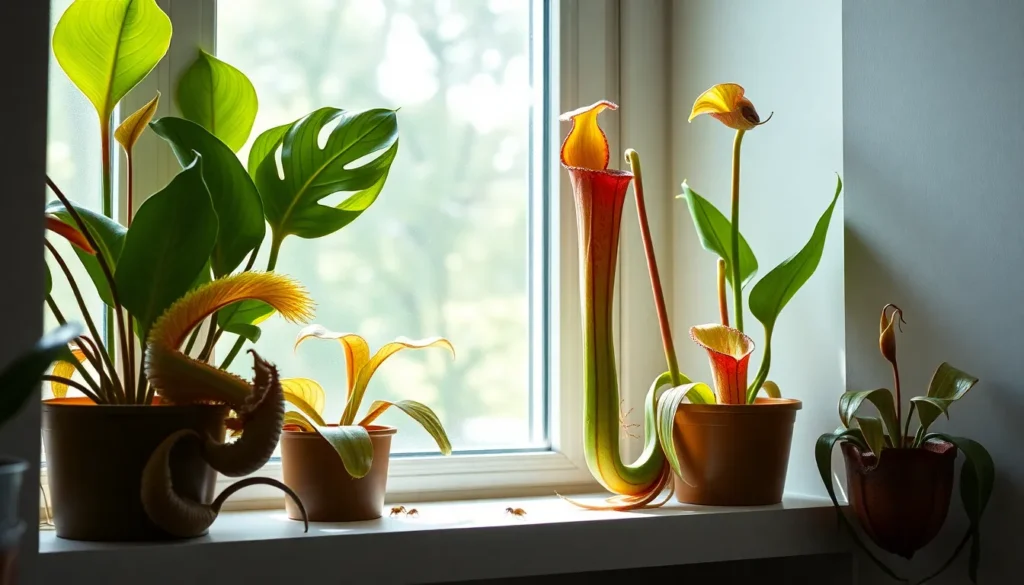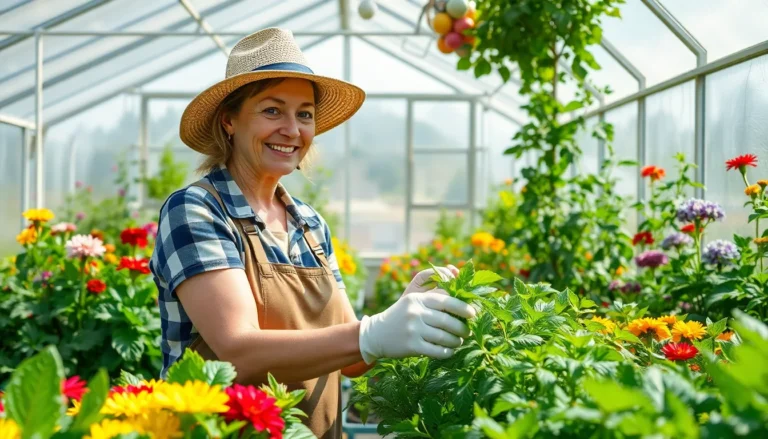Table of Contents
ToggleImagine a houseplant that doesn’t just sit there looking pretty but actively hunts down pests like a tiny green predator. Carnivorous houseplants bring a dash of excitement to any home, turning the mundane into the extraordinary. These quirky botanical wonders not only add a unique flair to decor but also help keep unwanted insects at bay.
Overview Of Carnivorous House Plants
Carnivorous houseplants captivate plant enthusiasts and casual owners alike. These fascinating plants attract, capture, and digest insects, offering a natural solution for pest control indoors. With a variety of species available, many people enjoy both their defensive traits and visual appeal.
Sarracenia, also known as pitcher plants, feature tubular leaves that trap insects. When bugs venture inside, they slide down into a pool of digestive fluid. This unique trapping mechanism disables prey, allowing the plant to absorb nutrients.
Dionaea muscipula, or the Venus flytrap, employs a different strategy. Its jaw-like leaves snap shut when insects touch sensitive hairs, effectively trapping them. This rapid movement makes the Venus flytrap one of the most recognizable carnivorous species.
Nepenthes, or tropical pitcher plants, offer additional variety. They produce hanging, elongated pitchers filled with liquid. These structures attract insects drawn to their nectar, making them effective at capturing pests while adding allure to any room.
Many of these plants thrive in low-nutrient environments, providing an excellent opportunity for enthusiasts to explore various care techniques. For example, they often prefer high humidity and bright, indirect light. Acquiring the right potting mix, usually a blend of sphagnum moss and perlite, ensures optimal growth.
Choosing carnivorous plants as housemates adds both beauty and function to indoor spaces. These plants stimulate conversation about unique gardening practices while improving the indoor ecosystem by managing unwanted pests.
Popular Types Of Carnivorous House Plants

Carnivorous house plants come in various species, each with unique characteristics and trapping mechanisms. Three popular types include the Venus flytrap, pitcher plants, and sundews.
Venus Flytrap
Dionaea muscipula, commonly known as the Venus flytrap, captivates with its jaw-like leaves. These leaves snap shut when triggered by unsuspecting insects, effectively capturing prey. This plant thrives in moist, acidic soil and prefers bright, indirect sunlight. Care requirements include regular watering with distilled water and a dormant period during winter. Many hobbyists enjoy cultivating these striking plants for their unique hunting ability.
Pitcher Plants
Sarracenia and Nepenthes represent the two main groups of pitcher plants, characterized by their tubular leaves that form water-filled pitchers. Insects are drawn to the nectar, leading them to fall into the fluid below. Distinctively, Sarracenia, often called North American pitcher plants, grow outdoors in boggy habitats, while Nepenthes thrive in more humid tropical environments. Providing adequate humidity and light is essential for healthy growth. These plants contribute not only to pest control but also to creating a visually appealing atmosphere.
Sundews
Drosera, known as sundews, features sticky glandular tentacles that trap insects. Upon capture, these tentacles curl to digest the prey, allowing the plant to absorb nutrients. Sundews thrive in well-drained, acidic soils and require high humidity levels. Light plays a significant role in their growth, with bright but indirect sunlight being ideal. Their adaptability and fascinating trapping method make sundews a favorite among carnivorous plant enthusiasts.
Care Tips For Carnivorous House Plants
Carnivorous house plants require specific care to thrive. Attention to light and water ensures they remain healthy and effective in pest control.
Light Requirements
Bright, indirect light is essential for carnivorous plants. Venuses flytraps thrive best with 12 hours of light a day. Sarracenia and Nepenthes prefer bright conditions but can tolerate some shade. Avoid placing these plants in direct sunlight, as it can scorch their leaves. Adequate light enhances their ability to photosynthesize and attract prey. Artificial grow lights can supplement insufficient natural light, especially during winter months.
Watering Techniques
Watering techniques play a crucial role in the health of carnivorous plants. Use distilled or rainwater rather than tap water to prevent mineral buildup. Maintaining consistently moist soil is vital for species like the Venus flytrap and sundews. Allow the soil to dry slightly between waterings but avoid letting it dry out completely. A tray method works well for many carnivorous plants, allowing them to absorb water from below. This technique mimics their natural habitat, where they typically grow in boggy environments.
Benefits Of Keeping Carnivorous House Plants
Enhancing indoor aesthetics stands as a key benefit of carnivorous houseplants. Their unique appearance sparks interest and serves as a conversation starter, enriching home decor. Alongside visual appeal, these plants also perform practical pest control. Regularly, they trap and digest insects, reducing the presence of unwanted pests in living spaces.
Improving the indoor ecosystem comes naturally to these plants. By eliminating insects, they promote a healthier environment without relying on chemical pesticides. Carnivorous plants thrive in low-nutrient conditions, contributing to a self-sustaining habitat. Importantly, this adaptation allows them to flourish in soil that might not support other types of houseplants.
Caring for carnivorous plants encourages engagement with nature. Their maintenance can foster an appreciation for plant life and biodiversity. Daily observations reveal fascinating behaviors, like the rapid closure of a Venus flytrap. Observing these actions can bring joy and wonder, particularly for families with children.
Moreover, maintaining these plants serves as an educational opportunity. Learning about various species, such as Sarracenia and Nepenthes, enhances knowledge of botanical diversity. Such understanding promotes curiosity about ecosystems and conservation efforts.
Improving air quality might also be an indirect benefit. As with many houseplants, carnivorous species can help filter indoor air, contributing to a healthier home. These plants, by virtue of their natural attributes, create an inviting atmosphere while aesthetically pleasing.
Incorporating carnivorous houseplants combines beauty with functionality. They captivate attention while simultaneously controlling pests, enriching both living spaces and occupant experiences.
Carnivorous houseplants offer a unique blend of beauty and practicality that can transform any indoor space. Their ability to naturally control pests while enhancing decor makes them an attractive choice for plant enthusiasts and casual decorators alike. By understanding their specific care requirements, anyone can successfully cultivate these intriguing plants, creating a thriving indoor ecosystem.
These plants not only spark conversation but also encourage a deeper appreciation for nature’s complexities. With the right conditions and care, carnivorous houseplants can thrive, enriching homes with their captivating presence and contributing to a healthier indoor environment. Embracing these botanical wonders adds a touch of the wild to everyday living.







